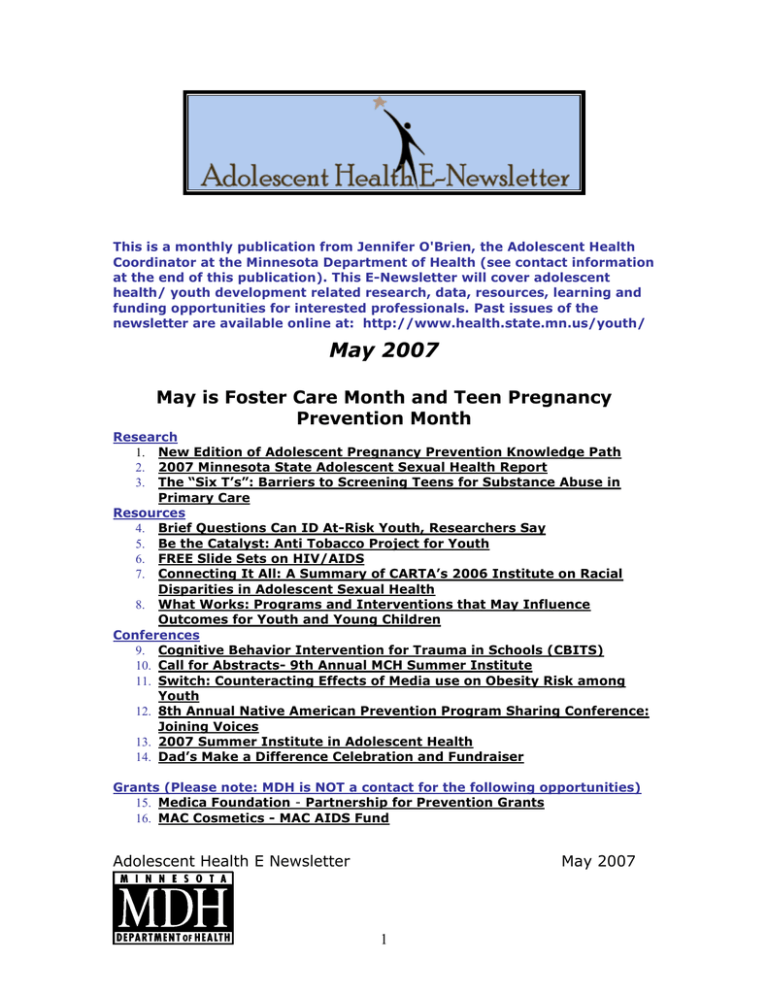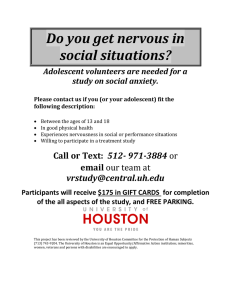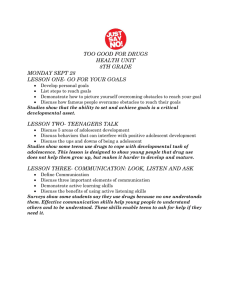(Word: 76KB/11 pages)
advertisement

This is a monthly publication from Jennifer O'Brien, the Adolescent Health Coordinator at the Minnesota Department of Health (see contact information at the end of this publication). This E-Newsletter will cover adolescent health/ youth development related research, data, resources, learning and funding opportunities for interested professionals. Past issues of the newsletter are available online at: http://www.health.state.mn.us/youth/ May 2007 May is Foster Care Month and Teen Pregnancy Prevention Month Research 1. New Edition of Adolescent Pregnancy Prevention Knowledge Path 2. 2007 Minnesota State Adolescent Sexual Health Report 3. The “Six T’s”: Barriers to Screening Teens for Substance Abuse in Primary Care Resources 4. Brief Questions Can ID At-Risk Youth, Researchers Say 5. Be the Catalyst: Anti Tobacco Project for Youth 6. FREE Slide Sets on HIV/AIDS 7. Connecting It All: A Summary of CARTA’s 2006 Institute on Racial Disparities in Adolescent Sexual Health 8. What Works: Programs and Interventions that May Influence Outcomes for Youth and Young Children Conferences 9. Cognitive Behavior Intervention for Trauma in Schools (CBITS) 10. Call for Abstracts- 9th Annual MCH Summer Institute 11. Switch: Counteracting Effects of Media use on Obesity Risk among Youth 12. 8th Annual Native American Prevention Program Sharing Conference: Joining Voices 13. 2007 Summer Institute in Adolescent Health 14. Dad’s Make a Difference Celebration and Fundraiser Grants (Please note: MDH is NOT a contact for the following opportunities) 15. Medica Foundation - Partnership for Prevention Grants 16. MAC Cosmetics - MAC AIDS Fund Adolescent Health E Newsletter May 2007 1 17. Targeted Grants to Increase the Well-Being of, and to Improve the Permanency Outcomes for, Children Affected by Methamphetamine or Other Substance Abuse 18. Youthful Offender Grants 19. Do Something -- GameStop Youth Grants ******************************************************** Research 1. New Edition of Adolescent Pregnancy Prevention Knowledge Path Available From http://www.MCHLibrary.info/Alert/default.html In recognition of National Day to Prevent Teen Pregnancy (May 2, 2007), the MCH Library has released a new edition of Knowledge Path: Adolescent Pregnancy Prevention. The knowledge path is an electronic guide to current, high-quality resources that measure, document, and monitor the problem; identify risk and protective factors; and report on promising intervention strategies. The knowledge path is intended for use by health professionals, policymakers, researchers, and others who are interested in tracking information on this topic. Separate sections identify resources for families and schools. The knowledge path is available at http://www.mchlibrary.info/KnowledgePaths/kp_adolpreg.html. 2. 2007 Minnesota State Adolescent Sexual Health Report This report contains the most recent data available on the sexual health of Minnesota adolescents. The report provides key sexual health indicators in a brief and easy to read format. Use this important information to develop and evaluate policies and programs that will promote the sexual health of adolescents in your communities. A copy of this report is available on the MN Organization on Adolescent Pregnancy, Prevention and Parenting (MOAPPP) website: http://www.moappp.org/Documents/2007AdoHealthReport.pdf Adolescent Health E Newsletter May 2007 2 3. The “Six T’s”: Barriers to Screening Teens for Substance Abuse in Primary Care Van Hook S, Harris S, Brooks T, Carey P, Kossack R, Kulig J, Knight J, and the New England Partnership for Substance Abuse Research (NEPSAR). Journal of Adolescent Health 40 (2007) 456-461 Abstract “Purpose: To identify barriers to adolescent substance abuse screening in primary care. Methods Focus groups were held at six primary care sites with a total of 38 providers. Providers brainstormed a list of barriers, collectively grouped similar barriers, and voted to produce a final ranked list. Two investigators qualitatively analyzed field notes and transcripts to triangulate findings, ranked the barriers across all sites by the number of groups identifying the barrier, then calculated a mean ranking (MR) for each. Results The most commonly identified barrier was insufficient time (MR 1.8). Lack of training in how to manage a positive screen was ranked second (MR 1.7), but was linked to the first. Providers reported they had enough time to administer a short screen, but insufficient time to manage a positive result during the well care visit. The need to triage competing problems (MR 3.0), lack of treatment resources (MR 3.3), tenacious parents who would not leave the room for a confidential discussion (MR 2.5), and unfamiliarity with screening tools (MR 3.0) were also noted by more than one group. Conclusions Insufficient time and lack of training in how to manage positive screens are the greatest barriers to screening adolescents for substance abuse. This suggests that some providers might differentially avoid screening youth who they suspect will screen positive, yet these patients would benefit most from early recognition. More research is needed on effective ways to manage positive substance abuse screens in primary care.” Adolescent Health E Newsletter May 2007 3 ******************************************************** Resources 4. Brief Questions Can ID At-Risk Youth, Researchers Say http://members.jointogether.org/ct/71AKHks16XTM/ A brief screening tool called the adolescent risk inventory (ARI) effectively identifies adolescents who may be at risk of engaging in alcohol and other drug use or other dangerous behaviors. 5. Be the Catalyst: Anti Tobacco Project for Youth Attached is information on a BlueCross BlueShield program to recruit youth to fight big tobacco. The program is seeking youth currently in 8th - 11th grades. (Next year they will be in 9th - 12th grades.) www.bethecatalyst.org The application deadline is May 24, 2007. If you have additional questions, please contact Andy Berndt: berndt@streetfactorymedia.com 6. FREE Slide Sets on HIV/AIDS CDC provides slide sets on HIV and AIDS that are available for use by others. HIV/AIDS Surveillance in Adolescents and Young Adults (through 2005) is now available at: http://www.cdc.gov/hiv/topics/surveillance/resources/slides/adolescen ts/index.htm 7. Connecting It All: A Summary of CARTA’s 2006 Institute on Racial Disparities in Adolescent Sexual Health Center for Applied Research and Technical Assistance – CARTA (via HTN) http://www.cartainc.org/PDFs/InstituteSummary_2006.pdf On November 15, 2006 CARTA hosted its second annual Institute on Racial Disparities in Adolescent Sexual Health titled as a one-day, preconference session for Healthy Teen Network's (HTN) National Conference. The Institute offered a candid discussion on the impact of structural racism and related factors on racial disparities in the sexual Adolescent Health E Newsletter May 2007 4 health of teens and the quality of adolescent reproductive health services. The Institute this year also offered two new modules as a result of 2005 participant feedback. The People's Institute for Survival and Beyond- (PISAB) facilitated the training module that examined the role of white privilege in perpetuating racial and ethnic disparities. In addition, CARTA's new racism analysis tool titled, Assessing Racial/Ethnic Equity: A Tool for Youth Development and Teen Sexual Health Providers explored the levels of racism existing among participants, their workplaces and communities. 8. What Works: Programs and Interventions that May Influence Outcomes for Youth and Young Children: Information on over 60 indicators of types of programs and interventions that may influence particular outcomes for teens and young children. Child Trends Data Bank http://childtrendsdatabank.org/WhatWorks.cfm *************************************************** Conferences/ Trainings 9. Cognitive Behavior Intervention for Trauma in Schools (CBITS) The Minnesota Department of Education is offering a 2 day training in Cognitive Behavior Intervention for Trauma in Schools (CBITS) MDE August 15 and 16. CBITS is a 10 session counseling curriculum is directed at middle school aged students 5th grade to 9th. Teams from school and community mental health programs are encouraged to attend. Attached is the announcement, with links to CBITS web sites and the training registration link. Or, to register now, click on this link: http://www.zoomerang.com/survey.zgi?p=WEB226BPDXSM9Q . See attached announcement. 10. Call for Abstracts- 9th Annual MCH Summer Institute The Center for Leadership Education in Maternal and Child Public Health at the University of Minnesota School of Public Health invites you to submit poster abstracts to display during the 9th Annual MCH Summer Institute on Addressing Health Disparities, “Culture, Adolescent Health E Newsletter May 2007 5 Communications and Health.” The Institute will be held at the Hubert H. Humphrey Conference Center (on the West Bank of the University on Minnesota-Minneapolis campus) on July 24-25, 2007. Posters should focus on current research and practice addressing social and health disparities that affect women, children, families, and communities. Suggested topics include: adolescent health, breastfeeding, child health, childhood injuries, childhood poverty, health communications, children with special health needs, genetics, health literacy, immigrant health, infant mortality, management and sustainability of programs, mental health, perinatal health, male and female reproductive health, welfare reform, and women’s health. We welcome submissions from students, faculty, and community organizations. Abstracts must be 250 words or less. Please include the following information in your abstract: (1) poster title, (2) list of all the authors (presenter first), credentials, and agency affiliation, (3) a brief introduction, (4) program/project description, (5) results, and (6) conclusions. Please submit abstracts no later than June 7, 2007 at 5:00 PM. For conference information and the poster submission form, please visit: http://www.epi.umn.edu/mch/events Questions? Jan Pearson, pearson@epi.umn.edu 612-626-8644 11. Switch: Counteracting Effects of Media use on Obesity Risk among Youth Date/time: May 31, 2007 3-5 pm Location: Cowles Auditorium, HH Humphrey Center, University of Minnesota, West Bank Campus Map and directions available at (http://www1.umn.edu/twincities/maps/WBU/WBU-map.html) Cost: Free, but an rsvp is required to assure availability of adequate seating, refreshments and educational materials. RSVPs should be sent to goeden@epi.umn.edu Adolescent Health E Newsletter May 2007 6 Presenter: David Walsh, PhD and the Family Director, National Institute of Media Description: Media use has increased among youth during the past few decades and is considered to be a risk factor for child overweight. This session will provide an overview of current trends in media use and the associations between health and excessive media use. Dr Walsh will also present results from an innovative intervention study called SWITCH, which was designed to reduce media exposure, increase physical activity and improve dietary intake among school-aged children. Suggestions for how to reduce media use among youth will also be discussed. 12. 8th Annual Native American Prevention Program Sharing Conference: Joining Voices July 16-18, 2007 Shooting Star Casino, Hotel & Event Center, Mahnomen, MN This year's conference is co-sponsored by the Minnesota Department of Human Services Chemical Health Division, American Indian Section and CSAP's Central CAPT. Joining Voices provides youth and adult participants the opportunity to : Learn about specific prevention programs and strategies that are being implemented with Native American youth audiences. Learn about evidence-based programs, principles, and practices. Talk with others who are interested in making prevention programs work efficiently and effectively. Strengthen a good path of life for youth. Strengthen connections among prevention programs throughout the Native American Nations. Prepare youth to become good elders. Learn about wellbriety programs and strategies for Native American youth. Conference Registration is now open! Register online at http://www.ccapt.org/joiningvoices/a_register.html. Participant registration fee: $30. Up to three youth per paid adult can attend for free. Adolescent Health E Newsletter May 2007 7 Registration deadline: June 29, 2007. Registration is limited, reserve your seat today! Interested in exhibiting and sharing materials? Exhibitor fee: $45 (includes meals and participant materials). Register online at http://www.ccapt.org/joiningvoices/e_register.html Conference brochure and hotel information can be found on our conference website at http://captus.samhsa.gov/central/joiningvoices.cfm Please contact me, Sarah Carsello, at 1-800-782-1878 ext. 132 or scarsello@miph.org for additional information. 13. 2007 Summer Institute in Adolescent Health The Center for Adolescent Nursing, Healthy Youth DevelopmentPrevention Research Center and Konopka Institute at the University of Minnesota, along with the Coordinated School Health and the Minnesota Organization on Adolescent Pregnancy, Prevention, and Parenting are proud to announce our 2007 Summer Institute in Adolescent Health. Please check out our program information link for more information on this wonderful opportunity. The registration link is also provided below, spots are filling quickly and the registration deadline is July 16th. If you have any questions please feel free to contact Jenna Baumgartner at 612-626-0606 or at baum0272@umn.edu. Program Information link: http://cpheo.sph.umn.edu/institute/adolescenthealth/ Registration link: http://ustar.ahc.umn.edu/register_event.cfm Adolescent Health E Newsletter May 2007 8 ******************************************************** Other 14. Dad’s Make a Difference Celebration and Fundraiser Tuesday, July 31, 2007 Minnesota Twins vs. Kansas City Ticket Price: $40 (Package includes DMAD Pre-game Event and upper deck reserved ticket to baseball game.) TICKETS available at: www.dadsmakeadifference.org (or see attachment for order form) ******************************************************** Grants (Please note: MDH is NOT a contact for the following opportunities) 15. Medica Foundation - Partnership for Prevention Grants This funding opportunity is designed to improve utilization and quality of preventive care in the areas of: pre-natal and post-natal care and screening for sexually transmitted diseases. Individual grants may be awarded for amounts up to $50,000. For more information, visit www.medica.com. Deadline: June 1 - June 22, 2007 16. MAC Cosmetics - MAC AIDS Fund Prevention programs with a specific focus on high risk populations such as youth, people over 50, African Americans, as well as Caribbean and African women living in Western cities will be considered. Typical grant size for program ranges between $5,000 and $25,000 depending on scope of project and our past history with an organization. Grant applications are accepted year-round and proposals are reviewed and awarded quarterly (usually March, June, September and December). For more information, visit www.macaidsfund.org. 17. Administration for Children and Families Administration on Children, Youth and Families, Children's Bureau Adolescent Health E Newsletter May 2007 9 “Targeted Grants to Increase the Well-Being of, and to Improve the Permanency Outcomes for, Children Affected by Methamphetamine or Other Substance Abuse” Due Date for Applications: 07/03/2007 The Administration for Children and Families (ACF), Children's Bureau, announces the availability of competitive grant funds authorized by the Promoting Safe and Stable Families (PSSF) program. These targeted grants will be awarded to regional partnerships that provide, through interagency collaboration and integration of programs and services, activities and services that are designed to increase the well-being of, improve permanency outcomes for, and enhance the safety of children who are in an out-of-home placement or are at risk of being placed in an out-of-home placement as a result of a parent's or caretaker's methamphetamine or other substance abuse. Full announcement can be found at: http://www.acf.hhs.gov/grants/open/HHS-2007-ACF-ACYF-CU0022.html 18. Youthful Offender Grants The U.S. Department of Labor is offering approximately $20 million for Youthful Offender Grants for three categories of projects: registered apprenticeships, educational achievement, and efforts to expand effective programs. – Visit: http://www.doleta.gov/sga/ 19. Do Something -- GameStop Youth Grants Do Something is accepting applications for its GameStop Youth grants program. The purpose of this program is to support creative proposals for solving local problems in three areas: health, community building, and the environment. Applicants should address Do Something’s core principles: 1) measurable change; 2) community focus; 3) long-term problem solving action; 4) creativity; and 5) diversity. Grants of $500 each will be awarded weekly throughout 2007. Eligible applicants must be 25 years old or younger. Adolescent Health E Newsletter May 2007 10 Deadline: Rolling For complete program information and application guidelines, please visit www.dosomething.org/gamestop_application Adolescent Health E Newsletter May 2007 11




